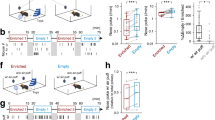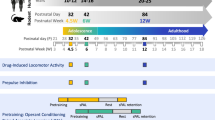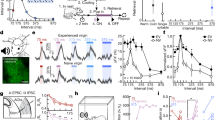Abstract
Behavioral transitions characterize development. Young infant rats paradoxically prefer odors that are paired with shock, but older pups learn aversions. This transition is amygdala and corticosterone dependent. Using microarrays and microdialysis, we found downregulated dopaminergic presynaptic function in the amygdala with preference learning. Corticosterone-injected 8-d-old pups and untreated 12-d-old pups learned aversions and had dopaminergic upregulation in the amygdala. Dopamine injection into the amygdala changed preferences to aversions, whereas dopamine antagonism reinstated preference learning.
This is a preview of subscription content, access via your institution
Access options
Subscribe to this journal
Receive 12 print issues and online access
$209.00 per year
only $17.42 per issue
Buy this article
- Purchase on Springer Link
- Instant access to full article PDF
Prices may be subject to local taxes which are calculated during checkout


Similar content being viewed by others
Accession codes
References
Maestripieri, D., Lindell, S.G., Ayala, A., Gold, P.W. & Higley, J.D. Neurosci. Biobehav. Rev. 29, 51–57 (2005).
Sullivan, R.M., Moriceau, S., Raineki, C. & Roth, T.L. in Cognitive Neuroscience IV (ed. M. Gazzaniga) 889–904 (MIT Press, Cambridge, Massachusetts, 2009).
Meaney, M.J., Sapolsky, R.M. & McEwen, B.S. Brain Res. 350, 159–164 (1985).
Sullivan, R.M., Landers, M., Yeaman, B. & Wilson, D.A. Nature 407, 38–39 (2000).
Moriceau, S. & Sullivan, R.M. Nat. Neurosci. 9, 1004–1006 (2006).
Moriceau, S., Wilson, D.A., Levine, S. & Sullivan, R.M. J. Neurosci. 26, 6737–6748 (2006).
Breitling, R., Armengaud, P., Amtmann, A. & Herzyk, P. FEBS Lett. 573, 83–92 (2004).
Galter, D., Buervenich, S., Carmine, A., Anvret, M. & Olson, L. Neurobiol. Dis. 14, 637–647 (2003).
Rosenkranz, J.A. & Grace, A.A. Nature 417, 282–287 (2002).
Bissière, S., Humeau, Y. & Luthi, A. Nat. Neurosci. 6, 587–592 (2003).
Pollak, D.D. et al. Neuron 60, 149–161 (2008).
Härfstrand, A. et al. Proc. Natl. Acad. Sci. USA 83, 9779–9783 (1986).
Overton, P.G., Tong, Z.Y., Brain, P.F. & Clark, D. Brain Res. 737, 146–154 (1996).
Herry, C. et al. Nature 454, 600–606 (2008).
Levine, S., Dent, G. & De Kloet, E.R. in Encyclopedia of Stress, Vol. 3 (ed. G. Fink) 518–526 (Academic Press, New York, 2000).
Acknowledgements
We thank L. Levita and the anonymous reviewers for helpful criticisms. This work was supported by grants NIH-NICHD-HD33402, NSF-IOB-0544406, NIH-NIDCD-DC009910 and the Leon Levy Foundation to R.M.S. and NIH-NIDA DA00325 and NIH-NIMH MH080603 to G.A.B.
Author information
Authors and Affiliations
Contributions
G.A.B. helped conceptualize and design the project, designed the microarray experiments, helped analyze the array and PCR data, and wrote the manuscript. S.M. helped conduct the behavioral, pharmacological studies, analyzed the data, and contributed to writing the manuscript. K.S. conducted the high-performance liquid chromatography studies. K.M. helped collect data for many of the experiments. P.G. analyzed the microarray and PCR data. S.W. conducted the microarray and PCR studies and carried out preliminary data analysis. R.M.S. helped conceptualize and design the project, supervised the behavioral, pharmacological, and dialysis studies, and helped write the manuscript.
Corresponding authors
Supplementary information
Supplementary Text and Figures
Supplementary Figures 1–4, Supplementary Tables 1–6 and Supplementary Methods (PDF 1162 kb)
Rights and permissions
About this article
Cite this article
Barr, G., Moriceau, S., Shionoya, K. et al. Transitions in infant learning are modulated by dopamine in the amygdala. Nat Neurosci 12, 1367–1369 (2009). https://doi.org/10.1038/nn.2403
Received:
Accepted:
Published:
Issue Date:
DOI: https://doi.org/10.1038/nn.2403
This article is cited by
-
Dopaminergic and cholinergic modulation of the amygdala is altered in female mice with oestrogen receptor β deprivation
Scientific Reports (2023)
-
Role of cryptic rearrangements of human chromosomes in the aetiology of schizophrenia
Journal of Genetics (2023)
-
Gradual wiring of olfactory input to amygdala feedback circuits
Scientific Reports (2020)
-
Neurobiology of maternal regulation of infant fear: the role of mesolimbic dopamine and its disruption by maltreatment
Neuropsychopharmacology (2019)
-
Developmental transitions in amygdala PKC isoforms and AMPA receptor expression associated with threat memory in infant rats
Scientific Reports (2018)



